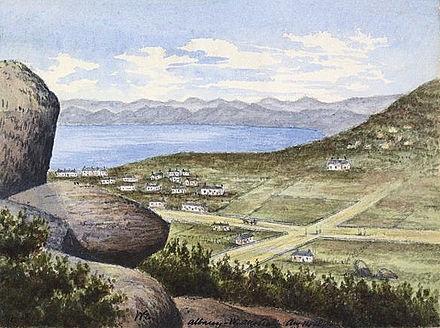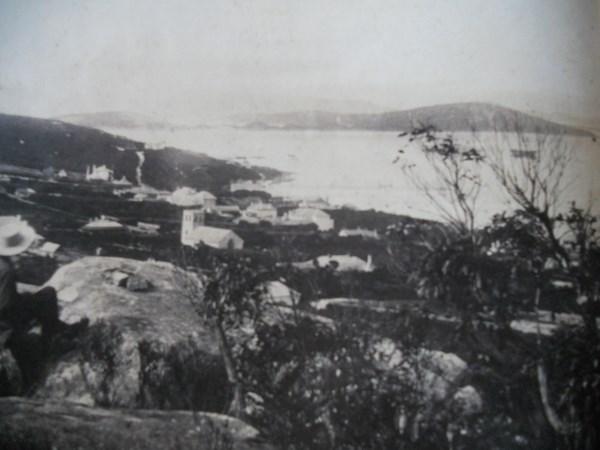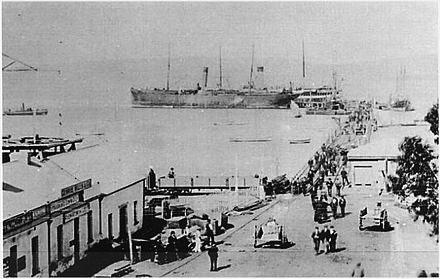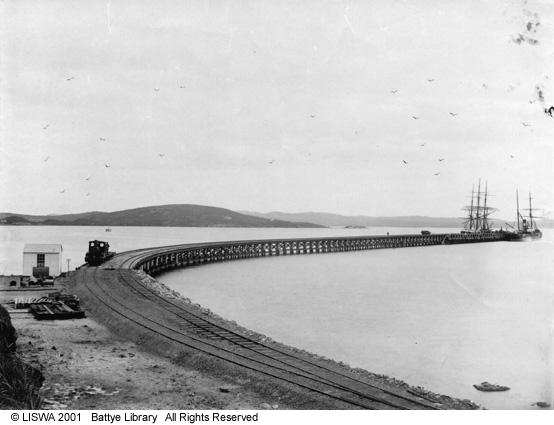Historical Timeline
Captain George Butcher was Harbour Master 1868 - 1900.
By 1870, kerosene lamps were hoisted at the seaward end of the jetty as guides for boats landing from mail steamers.
In 1868-70, the Government built three-storeyed offices at the end of Spencer Street. The lower storey, a bonded store, adjoined the jetty.
Extensions to the Town Jetty in 1873 and the construction of an iron crane to the south-west corner of the jetty head were made.

A cottage and a jetty were constructed on Vancouver Peninsula (current-day Quaranup) following many cases of dangerous and deadly diseases brought to Albany. The facility was enlarged and effectively ceased its intended use in 1930.
During WWII from 1942, American troops were billeted there for R&R.

Sold for demolition on the 8th September 1876, it is believed to have been burnt to the waterline and broken up over the years. The original figurehead (of a male) is now in the Museum of the Great Southern.
She was used to announce to the town the arrival of an incoming ship, by the Breaksea Island lighthouse-keeper signalling to ‘Larkins’, which would fire a 6-pounder cannon or a flare at night.
The Harbour and Light Department was constituted in 1880 under the Chief Harbour Master, Fremantle. The Department was responsible for control of all maritime matters, including lighthouses and other navigation aids and the administration of the shipping and pilotage legislation. The Department controlled the ports of Albany, Vasse (Busselton), Bunbury, Geraldton, Port Irwin and Cossack and it operated lighthouses at Bunbury, Bluff Leading Light, Breaksea, Cossack, Fremantle, Point Moore, Port Irwin, Point King, Rottnest Island and Vasse.
The Town Jetty was handed over from the Municipality to the colonial government (Harbour & Light and Railways Department).

When the SS ‘INDIA’ arrived on 7th April from Mauritius and departed on 13th April bound for Melbourne, nobody knew that she had a dark secret.
Built in Scotland, of 347 tons and 170 feet (52m) long, with the name ‘Ferret’, she was chartered for a cruise, but sailed to Brazil with a false name of ‘Bantam’ then another of ‘India’.
It was not until an observant policeman in Melbourne noticed the old ‘Ferret’ name under her new one, that the culprits were arrested and given 7 years in prison.
Reverting to her old ‘Ferret’ name, she was bought by Adelaide Steamships and ironically ended up as a mail steamer between Melbourne, Albany and along the WA coast to Fremantle and further north for many years.
‘Bantam’ was wrecked in South Australia on 14th November 1920.
In July 1886 a contract was let which commenced the Great Southern Railway, connecting Albany to Perth. October saw the arrival of the ‘Gulf of St Lawrence’, with 250 tons of iron rail, with 211 migrants to connect a new jetty to the railway. The first pile was ceremoniously rammed, the first of 565 karri piles, by Mrs Young, wife of the WA Land Company Managing Director on 29th March 1887.
The Ship Inn was demolished to make way for the Great Southern Railway. The Inn established in 1843, was located on the shore on the west side of the jetty.
The jetty ran a curved path from the foot, straightening to the head; a total of 518m with a depth at the head of 10m.
The first ship to use the still in-progress jetty was the barque ‘Vivid’, arriving on 17th October, discharging 400 tons of timber.

The jetty was completed in October 1888, declared ready for receiving ‘mail steamers or vessels of any class’ and was formerly opened on 1st June 1889, although ships had been using it since October 1887.
Government declared the jetty an official landing place from 1st January 1889, and appointed a Tide Waiter (customs officer) to now collect duty.
